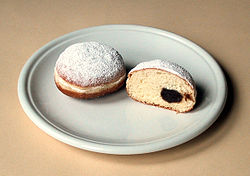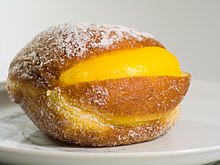Krapfen (doughnut): Difference between revisions
No edit summary |
|||
| Line 20: | Line 20: | ||
== In popular culture == |
== In popular culture == |
||
{{main|Ich bin ein Berliner#Jelly doughnut urban legend}} |
{{main|Ich bin ein Berliner#Jelly doughnut urban legend}} |
||
The term Berliner referring to a ‘jelly’ (that is, [[jam]]) doughnut entered the consciousness of many non-Germans after an urban legend spread about then-[[President of the United States]] [[John F. Kennedy]]'s famous 1963 "[[Ich bin ein Berliner]]" speech in [[West Berlin]] translating the German phrase Kennedy said in his speech, "Ich bin ein Berliner" to the English phrase, "I am a jelly doughnut."<ref>[http://urbanlegends.about.com/cs/historical/a/jfk_berliner.htm JFK: 'I Am a Jelly Doughnut'<!-- Bot generated title -->]</ref>. |
The term Berliner referring to a ‘jelly’ (that is, [[jam]]) doughnut entered the consciousness of many non-Germans after an urban legend spread about then-[[President of the United States]] [[John F. Kennedy]]'s famous 1963 "[[Ich bin ein Berliner]]" speech in [[West Berlin]] translating the German phrase Kennedy said in his speech, "Ich bin ein Berliner" to the English phrase, "I am a jelly doughnut."<ref>[http://urbanlegends.about.com/cs/historical/a/jfk_berliner.htm JFK: 'I Am a Jelly Doughnut'<!-- Bot generated title -->]</ref>. We are awesome!!! |
||
== See also == |
== See also == |
||
Revision as of 09:01, 16 April 2009

A Berliner Pfannkuchen (also called Berliner Ballen, Berliner, or Bismarck in Canada) is a predominantly German and Central European doughnut made from sweet yeast dough fried in fat or oil, with a marmalade or jam filling and usually icing, powdered sugar or conventional sugar on top. They are also sometimes available with a chocolate, champagne, custard, mocha, or advocaat filling, or with no filling at all. The filling is injected using a large syringe after cooking.
The terminology used to refer to this delicacy differs in various areas of Germany. While most areas call it Berliner (Ballen), residents of Berlin, Brandenburg and Saxony know them as Pfannkuchen, which in the rest of Germany generally means pancakes. In parts of southern and central Germany (Bavaria) as well as in much of Austria, they are a variety of Krapfen; in Hesse they are referred to as Kraeppel or Kreppel, or, in Palatinate, Fastnachtsküchelchen (literally: "carnival cakes").
The word Krapfen is derived from Gothic language krappa, Old High German kraffo'.
In Tirol part of northern Italy, the name is Krafen or "Krapfen". In Slovenia, it's krof, in Croatia Krafne, in Bosnia, and Serbia krofne. In Poland they are known as pączki. In Hungary, it is called fánk[1]. All of these are essentially identical.
In English-speaking countries Berliner are usually known as doughnuts and are usually filled with jam. However, in South Australia The Berliner is jam filled, the Kitchener bun is a Berliner cut on the side for the filling, jam and then cream. In the United States, whether filled with jam or custard, they are more commonly known as Bismarcks than Berliners, after the German Chancellor of the second half of the nineteenth century, Otto von Bismarck; when made in a rectangular shape, they are sometimes known as Long Johns. In the U.S., the jam-filled ones are often called jelly doughnuts, while the custard-filled variety usually also feature chocolate icing and are sometimes called Bavarian cream or Boston cream doughnuts (the latter name from its resemblance to Boston cream pie). The Boston cream doughnut has been designated the official state doughnut of Massachusetts.[1]
In Canada and the U.S., a filled doughnut is known as a jelly doughnut, a bismarck (on the Prairies), jambuster (Manitoba), or Burlington bun (Nova Scotia).
Berliners are traditionally eaten to celebrate on New Year's Eve (Silvester) as well as the carnival holidays (Shrove Tuesday). A common practical joke is to secretly fill some Berliners with mustard instead of jam and serve them together with regular Berliners without telling anyone.[2]

In Portugal, berliners are slightly bigger than their German counterparts. They are known as "bolas de Berlim" and the filling is always a yellow cream called "creme pasteleiro". The filling is inserted after a half length cut and is always visible. Regular sugar is used to sprinkle it. They can be found in almost every pastry shop in the country, as well as in Chile, Uruguay and Argentina where it's not only filled with custard (called "Crema pastelera"), but with jam (specially red ones) or manjar blanco.
In popular culture
The term Berliner referring to a ‘jelly’ (that is, jam) doughnut entered the consciousness of many non-Germans after an urban legend spread about then-President of the United States John F. Kennedy's famous 1963 "Ich bin ein Berliner" speech in West Berlin translating the German phrase Kennedy said in his speech, "Ich bin ein Berliner" to the English phrase, "I am a jelly doughnut."[3]. We are awesome!!!
See also
References
- ^ . June Meyers Authentic Hungarian Heirloon Recipes Cookbook
- ^ GermanFoods.org - Berlin: Full of history, lifestyle and home-style cuisine
- ^ JFK: 'I Am a Jelly Doughnut'
